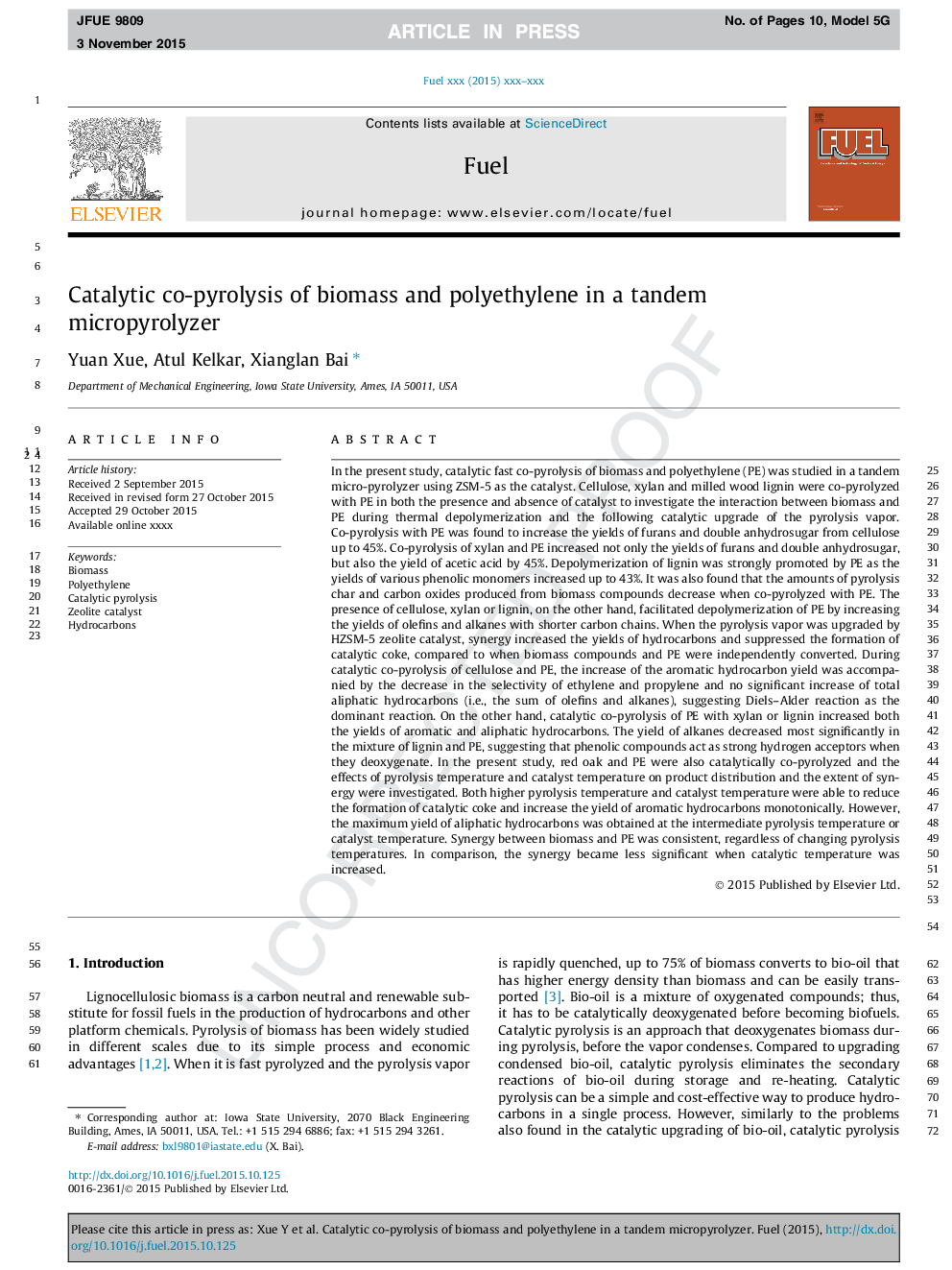| کد مقاله | کد نشریه | سال انتشار | مقاله انگلیسی | نسخه تمام متن |
|---|---|---|---|---|
| 6634242 | 461106 | 2016 | 10 صفحه PDF | دانلود رایگان |
عنوان انگلیسی مقاله ISI
Catalytic co-pyrolysis of biomass and polyethylene in a tandem micropyrolyzer
ترجمه فارسی عنوان
کمپیرلیلی کاتالیزوری زیست توده و پلی اتیلن در یک میکروپرولیزر دو طرفه
دانلود مقاله + سفارش ترجمه
دانلود مقاله ISI انگلیسی
رایگان برای ایرانیان
کلمات کلیدی
زیست توده، پلی اتیلن، پیرولیز کاتالیستی، کاتالیزور زئولیت، هیدروکربن ها،
موضوعات مرتبط
مهندسی و علوم پایه
مهندسی شیمی
مهندسی شیمی (عمومی)
چکیده انگلیسی
In the present study, catalytic fast co-pyrolysis of biomass and polyethylene (PE) was studied in a tandem micro-pyrolyzer using HZSM-5 as the catalyst. Cellulose, xylan and milled wood lignin were co-pyrolyzed with PE in both the presence and absence of catalyst to investigate the interaction between biomass and PE during thermal depolymerization and the following catalytic upgrade of the pyrolysis vapor. Co-pyrolysis with PE was found to increase the yields of furans and double anhydrosugar from cellulose up to 45%. Co-pyrolysis of xylan and PE increased not only the yields of furans and double anhydrosugar, but also the yield of acetic acid by 45%. Depolymerization of lignin was strongly promoted by PE as the yields of various phenolic monomers increased up to 43%. It was also found that the amounts of pyrolysis char and carbon oxides produced from biomass compounds decrease when co-pyrolyzed with PE. The presence of cellulose, xylan or lignin, on the other hand, facilitated depolymerization of PE by increasing the yields of olefins and alkanes with shorter carbon chains. When the pyrolysis vapor was upgraded by HZSM-5 zeolite catalyst, synergy increased the yields of hydrocarbons and suppressed the formation of catalytic coke, compared to when biomass compounds and PE were independently converted. During catalytic co-pyrolysis of cellulose and PE, the increase of the aromatic hydrocarbon yield was accompanied by the decrease in the selectivity of ethylene and propylene and no significant increase of total aliphatic hydrocarbons (i.e., the sum of olefins and alkanes), suggesting Diels-Alder reaction as the dominant reaction. On the other hand, catalytic co-pyrolysis of PE with xylan or lignin increased both the yields of aromatic and aliphatic hydrocarbons. The yield of alkanes decreased most significantly in the mixture of lignin and PE, suggesting that phenolic compounds act as strong hydrogen acceptors when they are deoxygenated. In the present study, red oak and PE were also catalytically co-pyrolyzed and the effects of pyrolysis temperature and catalyst temperature on product distribution and the extent of synergy were investigated. Both higher pyrolysis temperature and catalyst temperature were able to reduce the formation of catalytic coke and increase the yield of aromatic hydrocarbons monotonically. However, the maximum yield of aliphatic hydrocarbons was obtained at the intermediate pyrolysis temperature or catalyst temperature. Synergy between biomass and PE was consistent, regardless of changing pyrolysis temperatures. In comparison, the synergy became less significant when catalytic temperature was increased.
ناشر
Database: Elsevier - ScienceDirect (ساینس دایرکت)
Journal: Fuel - Volume 166, 15 February 2016, Pages 227-236
Journal: Fuel - Volume 166, 15 February 2016, Pages 227-236
نویسندگان
Yuan Xue, Atul Kelkar, Xianglan Bai,
